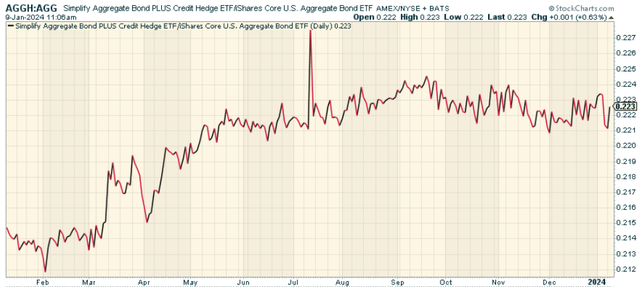BlackJack3D
Hedging bonds is always an interesting thing to do, and something that few understand how to accomplish on their own. That’s why ETFs like the Simplify Aggregate Bond ETF (NYSEARCA:AGGH) are interesting for those who want bond exposure but are nervous around risks beyond the potential to get an ongoing stream of income.
AGGH aims to deliver maximum total return by primarily investing in investment-grade bonds while concurrently mitigating credit risk. AGGH is an actively managed exchange-traded fund, or ETF, enhancing yield through efficient curve positioning and selling interest rate and credit volatility.
AGGH’s Holdings: A Closer Look
AGGH’s portfolio is an interesting mix of bonds, bond ETFs, and a variety of hedging mechanisms. The fund primarily holds other bond ETFs, accounting for a significant portion of the fund’s weight. Some of the well-known and highly liquid bond ETFs in AGGH’s portfolio include iShares Investment Grade Corporate Bond ETF (LQD) and iShares Core U.S. Aggregate Bond ETF (AGG).
In addition to holding bonds, AGGH adopts a more complex approach to maximize yield and mitigate risk. This includes writing covered calls, buying protective puts, option spreads, and purchasing credit default swaps („CDS“) as insurance against potential black swan events.
AGGH’s Performance: What do the Numbers Say?
Since its inception, AGGH has outperformed AGG when it counted in the first half of 2023. When we look at the ratio of AGGH relative to AGG, we can clearly see the hedging and active management has indeed resulted in outperformance.
stockcharts.com
Distributions & Yield – A Critical Component
One of the attractive features of AGGH is its distribution yield. The fund currently pays a monthly distribution amounting to an annualized forward yield of a little over 11%. However, it’s important to note that this distribution is classified as ordinary income, which is taxed at the same rate as one’s income bracket.
The fund’s distribution has increased quite dramatically in the past few months, making it an appealing option for yield-hungry investors. However, it’s important to ascertain whether this distribution is sustainable or merely a result of liquidating the fund’s Net Asset Value.
AGGH: Comparisons with Peer ETFs
AGGH’s approach of selling covered calls on bond funds is reminiscent of similar funds such as iShares 20+ Year Treasury Bond BuyWrite Strategy ETF (TLTW), which writes covered calls on TLT, iShares High Yield Corporate Bond BuyWrite Strategy ETF (HYGW), which writes covered calls on HYG, and iShares Investment Grade Corporate Bond BuyWrite Strategy ETF (LQDW), which writes covered calls on LQDW. These funds also write calls very close to the money and do not use any special hedging. There’s a time for each of these types of products, so if you view risk as rising in bonds, these are worth considering.
Evaluating the Pros and Cons
Like any investment, AGGH comes with its own set of advantages and disadvantages. On the positive side, the fund’s strategy of writing covered calls and buying protective puts can enhance yield and provide a buffer against potential downturns. On the flip side, the fund’s high portfolio turnover and complexity might not appeal to all investors.
Conclusion: To Invest or Not to Invest?
Investing in Simplify Aggregate Bond ETF can be a viable option for investors seeking income from a basket of bond ETFs, enhanced by covered calls and hedged with different vehicles. However, it’s crucial to bear in mind that AGGH is not a typical aggregate bond fund but acts more like an unconstrained fixed income hedge fund that trades based on the manager’s views on duration and credit. I think it’s an interesting fund to consider overall.











